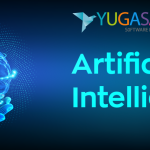AI in agriculture: Using data and equipment such as smart drones, autonomous tractors, soil sensors, and AI in agriculture helps farmers achieve efficiency.
Agriculture is one of the essential methods of cultivating crops and rearing animals. With modern technology, we have gone a long way in how we farm and produce new crops.
The world’s population is overgrowing, with UN estimations predicting that the global population would reach 9.7 billion in 30 years.
So, to feed everyone while also addressing climate change, we’ll need to produce 50 percent more food in the same area by 2050 and cut agricultural-related greenhouse gas emissions.
With such aims in mind, we must explore methods to modernize our agricultural processes, and artificial intelligence in agriculture is a better approach to do it.
In agriculture, AI-based technology aids farmers in producing better crops, managing pests, detecting growth conditions, monitoring soil, organizing data, and assisting them with a variety of activities.
Precision farming and predictive analytics are two ways AI is applied in the agricultural industry.
Let’s have a look at the market growth of AI in agriculture using the numbers below:
Overview of the Market- AI in agriculture
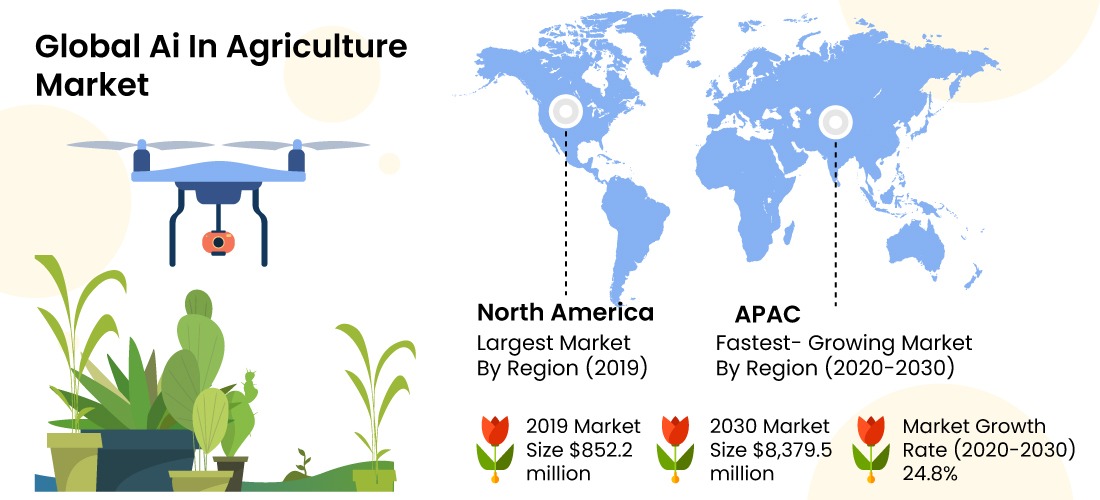
According to Markets and Markets, investment in AI technologies and solutions in agriculture is expected to increase from $1 billion in 2020 to $4 billion in 2026, representing a 25.5 percent compound annual growth rate (CAGR).
The market for AI in agriculture was worth $852.2 million in 2019, and it is predicted to grow to $8,379.5 million by 2030, with a CAGR of 24.8 percent from 2020 to 2030.
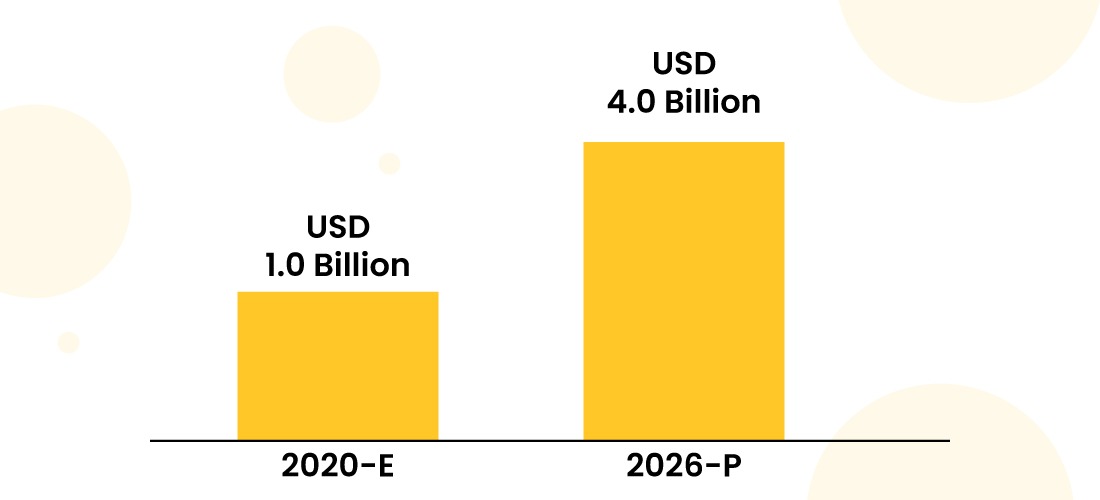
Agriculture AI market in the world
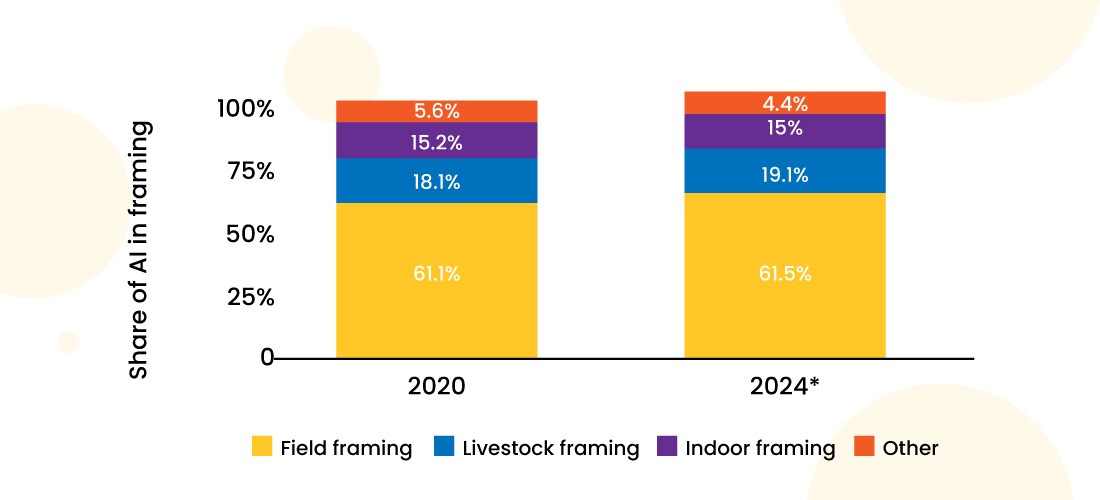
In 2019, artificial intelligence will be used primarily on the field, livestock, and indoor farming.
With more than 60% market share, field farming is the most common farming type where AI is utilized in agriculture.
The adoption rate of artificial intelligence in agriculture has transformed the overall result of farming activities, with most agricultural startups using AI-enabled ways to boost agricultural output efficiency.
Let’s look at how AI will affect agriculture in the future.
1. Weather forecasting
Over the years, pollution levels have risen, and climatic conditions have become more unpredictable.
Farmers are finding it harder to decide the best time to plant seeds due to climate change; where AI comes, farmers will examine and plan when to plant their seeds using weather predictions.
Use case: In the event of a weather interruption, IBM weather prediction sends out notifications and offers integrated solutions to optimize agricultural yields, limit environmental impact, and save money.
2. Real-time soil and crop monitoring
Soil is one of the most critical components in determining a plant’s development and health. The soil’s nutrition determines the quality of the harvest.
Because of deforestation, soil quality deteriorates with time, making it difficult for farmers to determine which soil is ideal for which crop.
Use Case: Plantix is an AI-based tool that helps farmers discover nutrient deficits in soil, plant pests, and other illnesses using picture recognition technology.
Farmers can quickly figure out which fertilizer to apply to boost the quality of their products with the aid of Plantix.
The software also offers advice and remedies for the issues that have been identified.
3. Using drones to acquire data
Crop production can be enhanced using real-time sensor data and visual analytics data from drones, thanks to AI and machine learning in agriculture.
Drones can offer real-time video observation and analysis of agricultural development trends.
Intelligent sensors, on the other hand, may offer information on moisture, fertilizer, and natural nutrient levels.
However, we cannot deny that drones are viable for obtaining data on how various fertilizers, irrigation patterns, and pesticide treatment approaches improve agricultural yields.
PrecisionHawk is a drone-based service that enables farmers to stroll around their fields virtually.
Drones are being used by farming businesses of all kinds, large and small, to cut the time and expenses connected with agricultural data collecting.
4. Farming with precision
AI in agriculture has produced apps that provide farmers advice on water management, crop rotation, timely harvesting, optimal planting, and insect assaults, among other things.
Precision farming is a method of increasing agricultural yields by using data inputs in exact proportions.
Farmers may acquire a tailored plan for their farms using their cellphones and AI software.
Farmers can satisfy the needs of our present and future worlds using IoT and AI-driven solutions, such as more excellent food production and profitability without depleting our natural resources.
Precision farming’s market worth is predicted to increase from about 5.09 million dollars in 2018 to 9.53 billion dollars in 2023.
5. AI-enabled robots
Companies using artificial intelligence are creating robots that can do various agricultural jobs.
These robots will be trained to control weed growth and harvest crops. They’ll be taught how to harvest and bag crops as well.
The objective is to automate such manual operations and do them at a considerably quicker rate with more significant quantities.
Use case: Agrobot robots can work 24 hours a day, seven days a week, increasing efficiency and lowering the cost of precision weeding, hoeing, and harvesting.
The Argobot E-series, with its powerful AI system, can not only detect crops but also determine their maturity in the field.
6. Surveillance systems using artificial intelligence – AI in agriculture
In agriculture, AI technology allows for comparing satellite photos with historical data to identify animal or human intrusions.
This eliminates the threat of any domestic or wild animal destroying crops. AI systems can even remember anything as little as a locust, grasshopper, or another bug.
When infiltration is discovered, farmers get warnings on their cellphones, allowing them to take the necessary safeguards.
Use case: The Plantix software transforms your smartphone into a mobile crop doctor, allowing you to identify pests and illnesses on your crops quickly.
Plantix is a full-service crop production and management system.
AI’s Agriculture Benefits
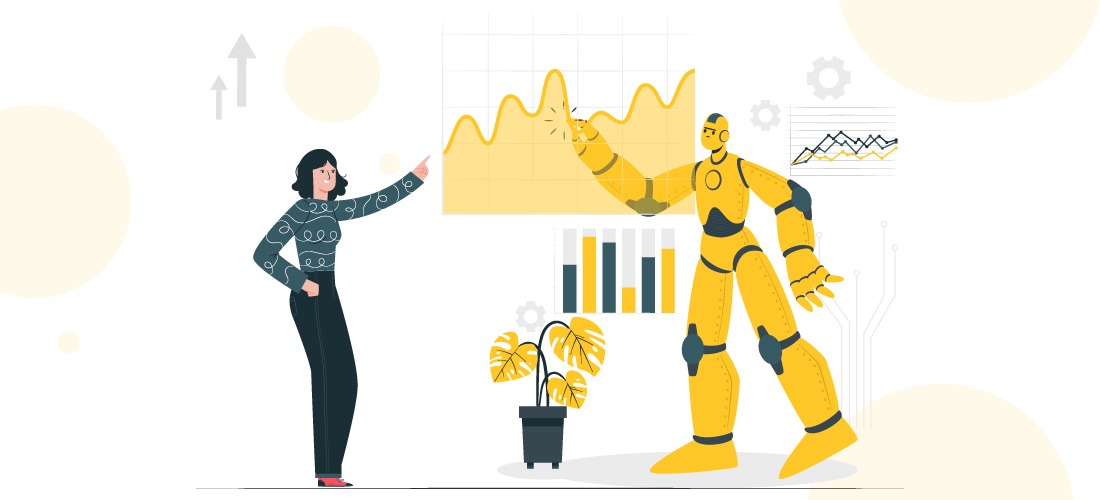
- Artificial intelligence (AI) in agriculture is a more effective method to grow, harvest, and market essential crops.
- Farmers may adapt more intelligently to climate change by incorporating AI-powered ideas into their agricultural practices.
- Artificial intelligence detects faulty crops and identifies pests to improve agricultural health and productivity.
- Intruders such as wild or domestic animals, as well as thieves, will be unable to spoil your crop thanks to AI.
- With the use of technology, crop management methods are enhanced. Farmers may generate a more considerable agricultural output with better quality using fewer resources.
- Artificial intelligence (AI) technology decreases the labor issue and automates manual labor, speeding up the food transformation.
Last Word
AI in agriculture: Agriculture’s technological improvements will aid the globe in dealing with food production difficulties as the world’s population grows.
Artificial intelligence advancements have bolstered agro-based enterprises, allowing them to operate more effectively than ever before.
If you’ve been seeking an AI app development business to help you realize your fantastic concept, now is the moment.
We also provide AI development services in the United States, Europe, and Asia to assist our customers and clients in achieving their objectives.
Read More: TOP 5 FARM MANAGEMENT SOFTWARE THAT CHANGES THE FACE OF AGRICULTURE IN 2021














